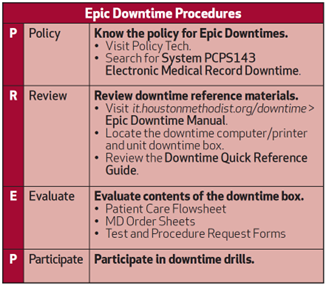Be Prepared: Always Maintaining Patient Care
In the seven years since Houston Methodist adopted Epic as our electronic health record, it has completely changed the way we care for our patients. We rely on Epic for everything from tracking vitals, placing orders and documenting care to communicating with patients. Because Epic is so important, it’s equally important that a scheduled or unscheduled downtime not be the cause for any interruption in patient care.
“Everyone has a responsibility to be prepared. That means expecting and planning for the unexpected, too,” said Lisa Stephenson, MSN, HM chief nursing informatics officer. “We pride ourselves on delivering the highest level of patient care. This means we need to be prepared regardless of weather events, interruptions of power or the need to bring Epic down for improvements and updates. We must be ready, every day, for whatever may come.”
The informatics team has been focusing on ways to help clinicians be prepared. In April, a series of downtime drills conducted on ED and inpatient nursing units systemwide highlighted opportunities for improvement. The drills uncovered the need for clinicians to have more practice and awareness of downtime workflows specific to their units or departments. This included knowing how to find and access downtime resources. Plus, it was evident that more information and training is needed for stat labs, results notifications and downtime recovery processes.

The downtime recovery process has been an area of focus and improvement, helping to minimize the length of time for planned downtime activities. In the past, the arrival, admission and movement of patients during the downtime had to be manually reconciled in Epic before everyone could access the system. Beginning with the Epic Update on Sunday, Sept. 17, we’ll move to a more automated electronic process in partnership with our patient access services team. The goal is to improve the workflow and reduce the overall time Epic is down. This benefits our patients and helps those who rely on Epic every day.
Preparation starts with P-R-E-P
With more downtime drills scheduled for September, and a planned downtime for the next Epic Update on Sunday, Sept. 17, a re-education effort is underway. Unit downtime checklists should be available soon and several resources are available, including downtime reminder badge buddies, an Epic Downtime Quick Start Guide and the HM Downtime website.
The badge buddies, which were first distributed in April, reinforce the steps you should take to prepare for an Epic downtime. You just need to remember P-R-E-P (see visual). The following resources are also available to help you through the next downtime:
- Epic/BCA Downtime Manual. Comprehensive role- and service-line-based processes and functions required to maintain patient care during a downtime and recovery process.
- Epic Downtime Quick Reference Checklist. A condensed snapshot of the most essential information you need to know in the event of either a scheduled or an unscheduled Epic downtime.
- Downtime Order Sets. Printable versions of order sets available in Epic. Intended as guides during downtime, when handwritten orders on blank order forms are needed.

Maintaining operations and patient care during an outage
Fortunately, a downtime doesn’t mean that all connected systems are unavailable. Every unit has a downtime computer and dedicated printer that operates on emergency back-up power. These are often in a red case or have a red sticker on them indicating they’re for downtime purposes. Nearby, your unit will have a downtime box, filled with forms for paper-based documentation.
Icons are also available for you on your Epic-enabled workstations, including Epic Read-Only and BCA Web. These read-only icons allow you to view patient data that was current as of the time Epic went down (see sidebar).
Unfortunately, access to certain data and some workflows will be disrupted during a downtime event. Integrated medical devices, like vitals and dialysis machines, ventilators, anesthesia carts and IV pumps may continue operating with emergency power, but their data may not be recorded and will not flow into Epic. You’ll need to manually document any changes or results.
The downtime recovery process has been an area of focus and improvement, helping to minimize the length of time for planned downtime activities. In the past, the arrival, admission and movement of patients during the downtime had to be manually reconciled in Epic before everyone could access the system. Beginning with the Epic Update on Sunday, Sept. 17, we’ll move to a more automated electronic process in partnership with our patient access services team. The goal is to improve the workflow and reduce the overall time Epic is down. This benefits our patients and helps those who rely on Epic every day.
Next steps to make sure you’re prepared
Our next Epic downtime will take place ahead of the Epic Update on Sunday, Sept. 17. Look for details from your informaticists on upcoming systemwide downtime drills, including other patient care areas, so you’re prepared. In advance of these, be sure you’re familiar with the necessary downtime workflows you may need to follow.
- Review the Epic downtime manual, specifically sections and workflows related to your unit/department.
- Find your unit’s downtime computer, printer and downtime box.
- Discuss any questions related to downtimes with your manager or charge nurse.
- Contact your nurse informaticist for a downtime badge buddy, if you don’t have one.
Putting the patient at the center of everything we do means being prepared for anything that may impact care. While downtimes may be a technical interruption, with a good understanding of our downtime resources and workflows you can help to ensure no interruptions to patient care.

Online Epic Downtime Icon Options:
Epic Read-Only
Available on most Epic-enabled workstations and through the Access Portal (access.houstonmethodist.org). This is a view-only system, so new documentation or orders can’t be added. Data is up to date as of the time when Epic went down. You’ll have limited access to patient data, but can still view active orders and the MAR, print patient labels and arm bands.
BCA Web
Access essential downtime reports from any workstation when you have internet access but Epic and Epic Read-Only are not available. View and print a current census or limited clinical summaries with data for each patient, including active orders, recent results and vitals. Also provides a printable downtime MAR for each patient and a respiratory patient summary.
Reports are automatically updated every 30 minutes for ICU patients and every two hours for non-ICU patients. Department Appointment Reports (including patient schedules for the next four weeks) for outpatient and PCG/SPG clinics are updated daily.
BCA Printing / Downtime Computer
Similar reporting functionality as BCA Web, but available from your unit’s designated downtime computer when internet access is not available. Your unit’s device will also have access to reports for sister units above and below you, in the event their system has issues. Because the computer is hardwired to a designated printer, you can mass print all reports for your unit and distribute patient data to the appropriate clinicians or staff.
